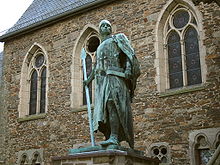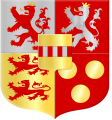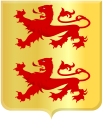House of Limburg-Stirum
This article is in prose. is available. (June 2018) |
| Limburg-Stirum | |
|---|---|
Wisch, Bronkhorst and Borculo , Oberstein, etc. |
The House of Limburg-Stirum (or Limburg-Styrum), which adopted its name in the 12th century from the
The Limburg-Stirum were imperial counts within the
Since the 9th century, the family counted five
The territorial authority of the family, counts of
, etc.Today's members are mostly found in Belgium and The Netherlands.
History
The Ezzonian dynasty
The Ezzonen appear in the chronicles with
The Ezzonian dynasty (named after Count Palatine
Famous members of the dynasty are:

- Konrad II(1024–1039). The Annales Hildesheimenses record that "Hezo Palatinus comes" died after catching pox from his concubine.
- Count Palatine of Lotharingia (1035–1045) and Duke of Swabia(1045–1047). After a successful campaign against the rebelling count of Flanders (margrave of Valenciennes and Ename), Otto received the duchy of Swabia in 1045 in exchange for the cities of Kaiserswerth and Duisburg, which went back to the crown. At the same time, the palatinate of Lotharingia was passed to his nephew.
- Stephen IX) had a love-affair with one of his relatives, he killed her with an axe. Heinrich then was enclosed into the abbey of Echternach, where he died in 1061.
- Bolesław I the Brave and Emperor Otto III. After she returned to Germany after the deposition of her husband in 1031, she became later a nun and today is revered as BlessedRicheza of Lotharingia, celebrated on 21 March.
- Duke of Bavaria, heir of Henry III, Holy Roman Emperor. He was deprived of the dukedom in 1053 when the Emperor installed his son as Duke. He died in exile after an attempt to assassinate the Emperor and seize the throne.
- Duke of Carinthiain 1057. The Annales of Berthold record the death in 1061 of Chounradus... Carantanis ducis.
- Hermann I, Archbishop of Cologne, Chancellor of King Zwentiboldof Lotharingia.
- (1053). He baptised and crowned the German king Henry IV.
- Count Palatine of Lotharingia (1064–1085), count of the Ruhrgau, Zulpichgau and Brabant. Hermann is assumed to be last of the Ezzonians. After his death (in a duel with Albert III of Namur, nearby his castle of Dalhem on 20 September 1085) the Palatinateof Lotharingia was suspended. His widow remarried with the first count palatine of the Rhine, Henry of Laach.
The surviving line of the
Counts of Berg



- Vogtof Deutz from 1008 until 1018.
- Vogtof Deutz.
- Vogtof Werden, Deutz, Berg and Gerresheim.
- Hövel, Unna, Telgte, Warendorf, etc. He founded the Altenberg monastery.
- Adolf III, Count of Berg from 1093 till 1132. His son, Eberhard of Berg, 1st Abbot of Georgenthal, convinced his brother Adolf IV to donate the Altenberg monastery to the Cistercian Order. His youngest son, Bruno II, Archbishop of Cologne, died in 1137 in Apulia on campaign with King Lothair of Germany against Roger II of Sicily.
- Adolf IV, Count of Berg from 1132 until 1160 and Count of Altena. He built the Schloss Altena, and built the Altenberg monastery, whose cloister he joined in 1160. He is father of one crusader (Adolf V, killed in Damascus in 1108), two Archbishops of Cologne and Duke of Westfalia and one Prince Bishop of Osnabrück.
- Engelbert I, Count of Berg from 1160 till 1189. He brought stability and prosperity to the county. In July 1189 he was killed on his way to the Holy Land with the Third Crusade.
- Berg passed under the regency of his brother Engelbert II, then to his daughter Irmgard.
- Engelbert II of Berg, Archbishop of Cologne, Regent of Berg from 1218 till 1225, better known as Saint Engelbert of Cologne. He was killed by his cousin Frederick of Isenberg (see below).
- Henry IVDuke of Limburg, and future Count of Berg.
Counts of Altena and Isenberg
, the counts of Schleiden, etc.The murder: from Isenberg to Limburg

There is no consensus as to whether it was a deliberately planned murder, or whether the Archbishop was killed in the heat of combat. Current research assumes the latter: Engelbert was intended to have been taken into "knightly detention" so that the political demands of the opposing nobility could be pushed through. This was in accordance with the customs of the medieval feuding ethos.
Frederick of Isenberg was outlawed and excommunicated. He was stripped of all offices and stewardships and his personal wealth was confiscated. In the winter of 1225/1226 the new Archbishop of Cologne, Heinrich von Müllenark, besieged and destroyed his castle. His cousin, Adolf von der Mark, was attributed large portions of Frederick's possessions and as such re-united the former territory of Altena.
Frederick travelled with his brothers Dietrich and Engelbert, bishops of
His son Count
16th to 18th century
Count Georg of Limburg-Styrum married in 1539 Irmgarde van Wisch, Lady of Wisch op Oud-Wisch, Wildenborch, Overhagen and Lichtenvoorde, hereditary Countess of Bronckhorst. She inherited the possessions of her uncle, the last count of Bronckhorst and Borculo. Her considerable possessions passed to her son Hermann Georg of Limburg, and the family settled in Gelderland. His grandson, Jobst of Limburg-Styrum, married Maria of Holstein-Pinneberg, heiress of the immediate lordship of Gemen and of Illereichen. Gemen remained for two centuries in the possession of the Counts of Limburg Stirum.
In 1644, the three sons of Hermann Otto I divided the family possessions among themselves:
Limburg Bronckhorst
Otto of Limburg obtained the territories of Bronckhorst and Borculo, founding the older line, still flourishing.
In the long conflict (known as the "Borculo question") between the heirs of the last count of
The lordship of Bronckhorst was sold in 1721 by Maria of Limburg Styrum and in 1726 the lordship of Borculo was sold by Count Leopold to the count of Flodorf.
Limburg Stirum Gemen
Adolf Ernst of Limburg Stirum obtained the immediate lordship of Gemen and Illereichen in the 1644 partition and ruled it until his death in 1657, founding the line of Limburg Stirum Gemen. In 1782, with the extinction of the Gemen branch, Gemen was inherited by the line of Limburg Stirum Iller-Aicheheim

- 1657-1675 - Countess Maria Isabella von Vehlen und Meggen zu Raesfeld, wife of Adolf Ernst, was regent of Gemen after the death of her husband. The reason for the long regency is not known.
- 1675-1704 - Battle of Höchstädt against the French-Bavarian forces. In 1704, he led the second assault on enemy positions in the Battle of Schellenbergand was mortally wounded, dying a few days later;
- 1704-1743 - Otto Leopold of Limburg Stirum and Bronckhorst, lord of Gemen and Raesfeld, inherited Gemen at the death of his father. He also inherited from his grandfather Alexander IV, Count von Velen zu Raesfeld the lordship of Raesfeld;
- 1743-1771 - Friedrich Karl of Limburg Stirum and Bronckhorst, lord of Gemen, son of Otto Leopold. He died in 1771 without descendants and both Gemen and Raesfeld passed to his brother, August Philip;
- 1771-1776 - Prince-Bishop of Speyer, Count of Limburg Stirum and Bronckhorst, lord of Gemen, brother of the above;
- 1776-1798 - Karl Josef, Count of Limburg Stirum, lord of Gemen, cousin of the above;
- 1798-1800 - Ferdinand IV, Count of Limburg Stirum zu Illereichen, grandson of the above, was the last lord of Gemen before it passed to the barons von Bomelberg in 1800.
In 1806, Gemen was mediatized to the princes of Salm-Kyrburg. It passed to France in 1810, then to Prussia in 1814.
Limburg Styrum

In the mediatisation of 1806, Styrum came under control of the Grand Duchy of Berg. The last count of Limburg-Styrum-Styrum, Ernst (deceased on 23 March 1809) left Styrum to the sister of his wife, Maria Margaretha von Humbracht, who sold it in 1825. Oberstein was mediatized at the Treaty of Lunéville in 1801, however Ernst was never compensated by the Final Recess of the Empire in 1803.
Mediatisation
The Limburg Stirum held seats in the Holy Roman Empire's
When the branch of Gemen became extinct in 1800, the branch of Styrum failed to inherit their possessions, and Gemen passed to the barons von Boyneburg-Bömelberg. In 1806 the
At the same moment Styrum was mediatised to the
19th century until today

The titles of the House of Limburg Stirum were confirmed in 1812 by
Notable figures in recent history are:
- King William I of the Netherlands, to The Hagueto avoid anarchy following the retreat of France's troops, and to avoid possible absorption of the Netherlands by Prussia or England.
- Menno David, Count of Limburg Stirum (1807–1891) was a Dutch general and government minister. He lost his right leg during the Siege of Antwerp (1832). After serving as Dutch minister of war he became aide-de-camp and advisor to King William III of the Netherlands.
- foreign minister of Germanyin 1880–1881.
- Mathilde van Limburg Stirum (1854-1932), secret fiancée of King William III of the Netherlands, and great-grandmother of Cara Delevingne.
- National Socialism, even refusing Nazi officials entry to the Dutch embassy. After leaving Berlin he would serve as Dutch envoy to London.
- Otto Ernst Gelder van Limburg Stirum was a Dutch magistrate and maternal uncle to Audrey Hepburn. As a prominent Dutchman he was taken hostage by the German occupiers and was one of five Dutchmen to be executed in retaliation for resistance activities on 17 April 1942. These five were the first Dutch hostages to suffer this fate.
- Knight of the Order of the Golden Fleece(Austrian branch).
- Franz von Limburg Stirum, a claimant to the headship of the House, lives in Finland.
Others
- The Limburg-Styrum Dragoons Regiment fought with six squadrons (500 men) during the battles of Schellenberg and Blenheim in 1704 during the War of the Spanish Succession; and in the Battle of Melle in 1745 during the War of the Austrian Succession. The Styrum Dragoons uniform was a red coat with green facings, white buttons and straw-yellow breeches. It was disbanded in 1748.[2]
- The Counts of Limburg Stirum created two orders of knighthood: the Order of the Four Emperors and the Order of St Philip of the Lion of Limburg. In 1806 the Counts of Limburg Stirum were mediatized and lost their rights on their territories. However the Order of St Philip of the Lion of Limburg was still in use until 1838.[citation needed]
- Limburg Stirum is also the name of a mountain, 2350 meters high, standing in the Belgica Mountains in Antarctic. It was discovered by the Belgian expedition (1957–58) under G. de Gerlache, who named it for Count Charles de Limburg Stirum, a patron of the expedition.[3]
- The Jerusalem Church in Bruges (Belgium) was founded in 1428 by the Adornes family. Anselm Adornes completed this remarkable building after his return from pilgrimage to Jerusalem. It was intended to be a copy of the Church of the Holy Sepulchre in Jerusalem. The Jerusalem Church is still today private property and belongs to the Limburg Stirum as direct descendants of the Adornes.[citation needed]
- In Belgium, Count Evrard de Limburg Stirum (1927–2001), the oldest son of Thierry, Count of Limburg Stirum and Princess Marie-Immaculée de Croÿ, married Princess Hélène d'Orléans (1934-), a daughter of Henri d'Orléans, Comte de Paris, the Orléanist claimant to the throne of France. After several years in Rhodesia, they settled in the Castle of Huldenberg in Belgium.[citation needed]
- Count Alexis de Limburg Stirum married, in the Castle of Ussé (France), Béatrix de Blacas d'Aulps, daughter of the 7th Duke and Prince of Blacas d'Aulps. They live in the castle of Walzin (Belgium).[citation needed]
- Count Rodolphe de Limburg Stirum, son of Count Christian de Limburg Stirum and grandson of Count Thierry, married on 6 December 2008 in Archduke Carl Christian of Austria. They have three sons (Leopold, Constantin and Gabriel).[citation needed]
Gallery
-
Original Arms of House of Isenberg used for the County of Altena
-
The Abbey of Brauweiler was founded in the early 11th century by Pfalzgraf Ezzo of Lotharingia and his wife Mathilde, daughter of the German Emperor Otto II, near Cologne, the place where their marriage had been celebrated.
-
Pfalzgraf Heinrich received the castleRichenza of Poland. She wanted to prevent her nephew Conrad Ifrom inheriting it.
-
In 1133, Count Adolf II built Schloss Burg on a mountain over the river Wupper. It remained the main residence of the counts of Berg until the 14th century.
-
Ancient arms of theCounts of Berg.
-
At the beginning of the 12th century Adolf II of Berg donated the site of their old ancestral castle, Schloss Berg, to Cistercian monks from Burgundy. Adolf IV later built the Altenberg Abbey.
-
Bust containing the relics of St Engelbert of Cologne, Engelbert II of Berg, Archbishop of Cologne, imperial administrator and guardian of Henry VII of Germany, whom he crowned in 1222 as King of the Romans. It was said that despite his personal piety he was more of a monarch than a churchman.
-
Count Dietrich von Altena-Isenberg, disinherited of all his territories following the execution of his father, fought to retrieve his paternal inheritance and built the castle ofLimburg an der Lenneand took the title of Count of Limburg.
-
Along with the title of counts of Limburg, the Isenberg changed their arms from the rose of Isenberg to thecounty of Limburg.
-
Count Frederick I of Altena purchased Schloss Mark near Hamm from the Edelherren of Rüdenberg and made it the residence of the new Counts of the Mark.
-
Count Georg of Limburg-Styrum acquired from his wife the county of Bronkhorst in 1539. It was ruled by the family until the 18th century.
-
Schloss Styrum around 1840, by Domenico Quaglio the Younger (Städtisches Museum Mülheim an der Ruhr). After the murder of Archbishop Engelbert of Berg, the descendants of Frederick II of Isenberg gained ownership of the castle as Lords of Styrum. They founded the line of Counts of Limburg Styrum.
-
The castle of Styrum today, near Mülheim in Germany.
-
Fürstbischof August von Limburg Stirum was overthrown by the French revolutionary troops and died in exile in Freudenhain castle, near Passau, Germany.
-
Oberstein was known as a gemstone centre, source for agate and jasper. It belonged to the Limburg Stirum until it was mediatizedin 1801.
-
Castle ofWisch, in Gelderland, was inherited by the Limburg Stirum in the 16th century from Irmgard von Wisch, Countess von Bronckhorst.
-
Ending a long succession dispute between the heirs of the last lords of Borculo, the Court of Gelders gave on 20 December 1615 the lordship of Borculo to Count Joost van Limburg and Bronkhorst.
-
Leopold of Limburg Stirum (1758–1840), member of the Driemanschap of 1813 with Frans van der Duyn van Maasdam and Gijsbert van Hogendorp.
-
The monument to Leopold of Limburg Stirum, G.K. van Hogendorp and F.A. van der Duyn van Maasdam on the 1813 square in The Hague.
-
Castle of Lichtenvoorde, in Gelderland, Netherlands
-
The castle fortress ofEsterhazy.
-
Menno van Limburg Stirum, as Minister of War, defended the suppression of military service in the Netherlands until he was sacked by the King who didn't share his view.
-
Louis Gaspard Adrien van Limburg Stirum, President of the Dutch Parliament in 1849 and Governor of Groningen and Gelderland.
-
The castle of Wemmel was given by the Limburg Stirum to the municipality, and now serves as town hall.
-
Opening of the Volksraad of the Dutch East Indies by Governor-General J.P. van Limburg Stirum in 1918.
-
Johan Paul van Limburg Stirum, Dutch Ambassador to Germany in 1924
-
The castle of Rumbeke in Belgium was inherited by the Limburg Stirum from Marie Therese Countess de Thiennes, Leyenburg et de Rumbeke.
-
The Order of St Philip of the Lion of Limburg was created by the Limburg Stirum to reward persons of exceptional scientific, artistic or civil virtue.
-
Mathilde van Limburg Stirum was the beloved of Crown Prince William of the Netherland. Their marriage was opposed by both King William III and Mathilde's father, Leopold van Limburg Stirum.
-
The Coloma castle in Sint-Pieters-Leeuw near Brussels dates from the 17th century. It was inherited by Albert de Limburg Stirum from the van der Dilft de Borghvliet family.
-
The current arms of the counts of Limburg Stirum display the arms ofWisch and Gemen.
-
Coat of arms ofLimburg. Also used by the provinces of Limburg (Belgium) and Limburg (Netherlands).
-
Coat of arms of Bronckhorst
-
Coat of arms ofWisch
-
Coat of arms of Borculo
-
Arms of Limburg Stirum
-
The castle of Walzin in Belgium belongs to Count Alexis de Limburg Stirum.
-
The House's coat of arm, as found in the stable at one of the family's estate in the Netherlands.
See also
Literature
- Genealogische Handbuch des Adels, Gräfliche Häuser A Band II, 1955;
- W. Gf v. Limburg Stirum, "Stamtafel der Graven van Limburg Stirum", 's Gravenhage 1878;
- A.M.H.J. Stokvis, "Manuel d'Histoire, de Genealogie et de Chronologie de tous les États du Globe", Tome III, Leiden 1890–93;
- W. K. Prins v. Isenburg, "Stammtafeln zur Geschichte der Europaischen Staaten", 2. Aufl., Marburg/Lahn, 1953.
References
- ^ Heinz Gollwitzer, Die Standesherren. Die politische und gesellschaftliche Stellung der Mediatisierten 1815-1918. Ein Beitrag zur deutschen Sozialgeschichte, Göttingen 1964
- ^ The Austrian Army 1740-80 (1): Cavalry, by Philip Haythornthwaite
- ^ "Mount Limburg Stirum". Geographic Names Information System. United States Geological Survey, United States Department of the Interior. Retrieved 2013-06-15.
External links

- Marek, Miroslav. "Genealogy of the counts of Altena, Berg and Limburg Stirum". Genealogy.EU.
- On Mount Limburg Stirum (Antarctic)








































